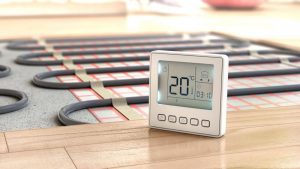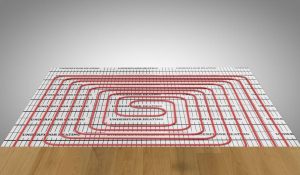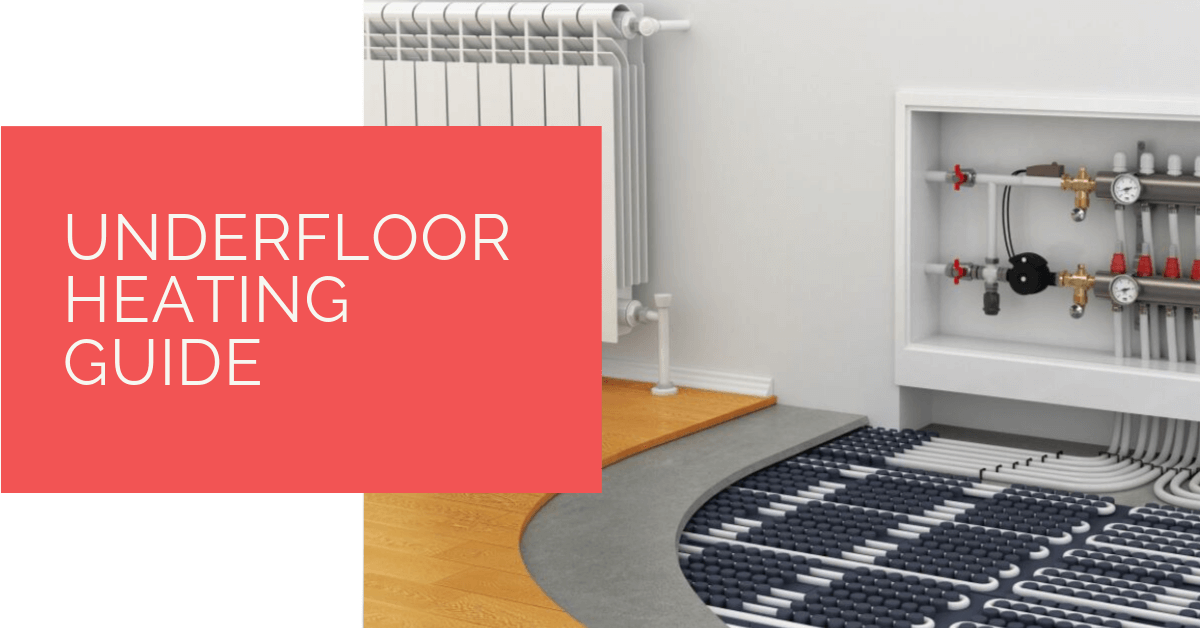A warm floor feels great and makes a home more comfortable. Whether it’s getting up in the morning or coming out of a shower or bath it’s nice to have the floor toasty warm. Here is our guide about underfloor heating.
Contents
- 1 Key Takeaways
- 2 What Is Underfloor Heating?
- 3 What Are The Advantages Of Underfloor Heating?
- 4 What Are The Disadvantages Of Underfloor Heating?
- 5 What Are The Different Types Of Underfloor Heating?
- 6 How Are Underfloor Heating Systems Installed?
- 7 How Much Does Underfloor Heating Cost?
- 8 How Much Does Underfloor Heating Cost To Run?
- 9 Heat Pump Source: Reliable Heating and Cooling Solutions
- 10 Conclusion
Key Takeaways
- Underfloor heating is a source of heat that warms up the floor, providing added comfort and energy-efficient heating. It can use electricity or heated water in pipes beneath the floor to achieve this.
- Underfloor heating offers several advantages, including increased comfort, reduced energy costs, and improved indoor air quality. It’s also aesthetically pleasing as there’s no visible heating source.
- There are two main types of underfloor heating: water-based systems and electrical systems. Water-based systems are more energy-efficient but may require significant floor modifications, while electrical systems are easier to install in existing buildings but may cost more to run.
What Is Underfloor Heating?
This is simply a source of heat that warms up the floor and can be used for added comfort or as a primary source of heat. It is most commonly used as a supplementary heat source that adds to the overall comfort of a room. If someone is walking around without shoes it keeps the floor from getting too cold.
If someone sits or sleeps on the floor then having it heated will help maintain comfortable temperatures for doing so. It also helps add overall heat to the entire room. Two main sources of heat typically come from either cables that run on electricity or with heated water that runs through pipes put in the floor.
What Are The Advantages Of Underfloor Heating?
It is currently becoming increasingly common to find heated floors being installed in new construction as well as being added to existing homes and offices. Homeowners quite like this added feature and it often attracts buyers. One of the big advantages of this feature is the added comfort that it gives. Heat radiates from the floor which not only keeps it more comfortable but also allows the heat to rise throughout the room. This often means that a room can feel pleasant even when the temperature is slightly lower.
 Using this type of heat often helps reduce energy costs for heating a room. Because of the fact that it is able to give the room a comfortable feel at lower temperatures it uses less energy in doing so. Even though the temperature of the room is lower and the energy consumption is equally lower the room still feels very comfortable.
Using this type of heat often helps reduce energy costs for heating a room. Because of the fact that it is able to give the room a comfortable feel at lower temperatures it uses less energy in doing so. Even though the temperature of the room is lower and the energy consumption is equally lower the room still feels very comfortable.
Having underfloor heating also means that there is no visible heater. Many people feel that heaters are unattractive and that makes underfloor heating a great option as it is not visible to the eye. This means that there is an invisible but very effective heating system being used.
This heat source is very clean which means the indoor air will be cleaner. According to some government studies, indoor air quality is several times worse than outdoor air quality in most homes and offices. Having this type of heat source will help improve the overall air quality inside.
What Are The Disadvantages Of Underfloor Heating?
One of the biggest disadvantages of this type of heat source is the fact that it’s most effective with certain types of floors and less so with others. If the floor is made of marble or tile then that is an ideal floor for this type of heating. If, on the other hand, the floors are wood or laminate the heat will not be as effective with this type of system.
To get the most use out of an underfloor heating system it will be necessary to have the room well insulated. If the room is not well insulated then the heating system will work less efficiently. This is especially true if the underfloor heating system is being used as a primary heat source.
To install an underfloor heating system the floor height will need to meet certain parameters. If the system is being installed in an existing property then this type of system can only be installed if the floor meets those parameters. If it doesn’t meet those parameters then expensive adjustments to the floor will be necessary if it is to be installed.
The initial installation of this type of system does have a price tag. It will be a bit higher than some other choices property owners could make. People find it advantageous to install an underfloor heating system because it ultimately pays for itself but it does require the upfront investment.
What Are The Different Types Of Underfloor Heating?
There are two main types of underfloor heating that someone can choose. One is heated water that runs through pipes under the floor. The other has coils that are heated by electricity that are under the floor.
Water Underfloor Heating
Using heated water is considered to be the most energy-efficient way of heating floors. In older buildings, it might have been common to see radiators that worked in a similar way and heated with radiant heat. The difference with an underfloor heating system that uses this type of heat is that the whole floor becomes a source of radiant heat. This allows it to work very efficiently.
 The only drawback to using this choice is the fact that if it is to be installed in an existing building it will often require a major overhaul of the floor. As would be expected, this can be time-consuming and costly. Other than the initial overhaul and cost it is nonetheless considered to be a great choice.
The only drawback to using this choice is the fact that if it is to be installed in an existing building it will often require a major overhaul of the floor. As would be expected, this can be time-consuming and costly. Other than the initial overhaul and cost it is nonetheless considered to be a great choice.
Electrical Underfloor Heating
If someone goes with an underfloor heating system that uses electricity they can avoid the need to overhaul their floor and raise it. Using underfloor heating kits makes this choice most popular for existing homes and buildings. Electricity heats up cables that are placed in the floor and a thermostat that is connected to the system helps regulate the temperature. The system is very slim and this makes it possible to lay it even with tile adhesive which makes it a very popular choice for bathrooms.
The only drawback to this choice is the fact that it will cost more in electricity than a system that uses water. In a new construction building, the water system is typically the most recommended because it will have long-term cost savings. In an existing building, however, a system that uses cables and electricity is often a reasonable choice because it’s easier and a considerably lower initial investment.
How Are Underfloor Heating Systems Installed?
Because this type of system doesn’t work as well without good insulation it will be necessary to put added insulation in the area that an underfloor heating system will be used. When someone is choosing to use a wet system then they will lay the pipe fittings and panels over the top of the added insulation. It will then be possible to install the pipes that will contain the water that produces the heat.
After the system has been fully installed it will be necessary to do a pressure test. This is done to make certain the system doesn’t have any leaks in the pipes, the joints, or the manifold. If everything was sealed appropriately then there will not be any leaks with the pressure test.
If someone is having an electrical system installed as their underfloor heating system it will install similarly to the wet system but with some key differences. A system that uses electricity will have thin wires that run underneath the flooring. This makes it easier to install in existing buildings and means that it isn’t necessary to raise the floor.
An electrical system gives a property owner two choices. The first choice is to use independent wires which allow a tailored installation. The second choice is installing heated mats that are pre-wired. This is a simpler option but doesn’t allow as much customisation.
How Much Does Underfloor Heating Cost?
 Having this type of system installed will vary in costs and the cost is based on which type of system is chosen and whether or not it is being installed in new construction or an existing building. For existing buildings, an electrical system is usually less involved and therefore cost less to install. In new construction, a wet system is very popular because the new construction can account for the underfloor heating system being installed and this system is ultimately less costly with its use of energy over the electrical system.
Having this type of system installed will vary in costs and the cost is based on which type of system is chosen and whether or not it is being installed in new construction or an existing building. For existing buildings, an electrical system is usually less involved and therefore cost less to install. In new construction, a wet system is very popular because the new construction can account for the underfloor heating system being installed and this system is ultimately less costly with its use of energy over the electrical system.
The installation cost per m2 can be expected to run £50-£75 when having heated mats and an electrical system. When going with a water underfloor heating system it will depend on whether or not it is being installed in a new construction building or an existing home. It is likely to cost at least £2,000O or more.
How Much Does Underfloor Heating Cost To Run?
Although an electrical system is less involved and less costly to install, they will cost more to run. If this type of system is being used in a fairly small room like a bathroom then it is unlikely to raise the utility bill very much. If it is run for about 6 hours it will cost about 10p for each metre squared. If someone is heating a typical sized bathroom then they could expect the added utility cost per month to be about £10.50.
An underfloor heating system that uses water will cost more to install but will usually reduce energy costs. In fact, if a home or building is currently using radiators to heat with they will no longer need to and the underfloor heating system will do a superior job with circulating heat. It will be possible to use lower temperatures and still be more comfortable and this lowers utility costs.
Heat Pump Source: Reliable Heating and Cooling Solutions
At Heat Pump Source, we take pride in our unwavering commitment to serving the UK with top-tier HVAC solutions. From the efficiency of heat pumps and the cool relief of air conditioning to the warmth of boilers, radiators, and underfloor heating, our dedicated team is always at the forefront of innovation. We understand the unique needs of every household and business, and we strive to provide dependable health and cooling products and services that are tailored just for you. Ensuring your comfort and satisfaction is our utmost priority. Whether you have questions, need guidance, or require support, we’re always here to assist. Please don’t hesitate to contact us; we’re eager to be of service.
Conclusion
Underfloor heating offers a comfortable and efficient way to warm your living spaces. It provides numerous benefits, such as enhanced comfort, energy savings, and cleaner indoor air. When choosing between water-based and electrical systems, consider your specific needs and circumstances. While the initial investment may vary, the long-term advantages of underfloor heating make it a compelling option for those seeking a cozy and cost-effective heating solution for their homes or offices.
About the Author
At Heat Pump Source, our articles are the product of a collaborative effort among a team of highly skilled HVAC experts. Our dedicated professionals, hailing from diverse backgrounds in heating, ventilation, air conditioning, and refrigeration, contribute their extensive knowledge and experience to every piece of content. This multidisciplinary approach ensures comprehensive coverage. Our commitment is to deliver authoritative, reliable, and tailored advice to meet the unique needs of every household and business across the UK.

